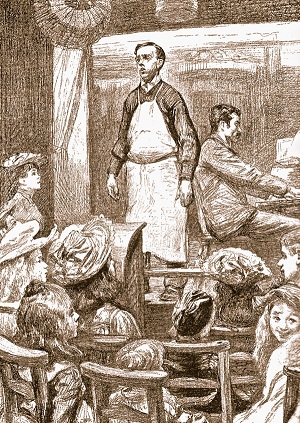Thanks for posting the link, Robert.
This analysis of these socialist/anarchist clubs based on their architecture and the aesthetics of their interiors is intriguing, but one ponders if this 'aesthetic banality' was born more out of necessity than some symbolic meaning referencing a repudiation of opulence. That certain journalists and others make note of these conditions, they still appear to be offered disparagingly rather than a mere descriptive observation.
Indeed it did, and by 1892, when the building was apparently about to be condemned, attendance had fallen off sharply as a result of the riff.
" The presence of Marx and Lasalle’s portraits alongside Proudhon’s at the Berner Street may have been a hangover of that club’s earlier days as a more ideologcally inclusive venue – a compromise between its socialist and anarchist adherents – whereas the emphasis on executed terrorists like Ravachol and O’Donnell at the Autonomie suggests less conciliatory motivations combining provocation with martyrology. Further explanation might be found in anarchism’s historical immaturity, which, in its anarcho-communist formulation had only recently emerged from the fallout of the Paris Commune a decade earlier (anarchism in general had a longer pedigree, but even this only dated, at least in Europe, to the 1840s)."
This analysis of these socialist/anarchist clubs based on their architecture and the aesthetics of their interiors is intriguing, but one ponders if this 'aesthetic banality' was born more out of necessity than some symbolic meaning referencing a repudiation of opulence. That certain journalists and others make note of these conditions, they still appear to be offered disparagingly rather than a mere descriptive observation.
Originally posted by ChrisGeorge
View Post
" The presence of Marx and Lasalle’s portraits alongside Proudhon’s at the Berner Street may have been a hangover of that club’s earlier days as a more ideologcally inclusive venue – a compromise between its socialist and anarchist adherents – whereas the emphasis on executed terrorists like Ravachol and O’Donnell at the Autonomie suggests less conciliatory motivations combining provocation with martyrology. Further explanation might be found in anarchism’s historical immaturity, which, in its anarcho-communist formulation had only recently emerged from the fallout of the Paris Commune a decade earlier (anarchism in general had a longer pedigree, but even this only dated, at least in Europe, to the 1840s)."





Comment